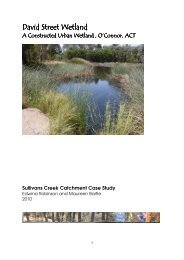4.2.2 Family Cyprinidae: Carps, Minnows etc. The Cyprinidae is one ...
4.2.2 Family Cyprinidae: Carps, Minnows etc. The Cyprinidae is one ...
4.2.2 Family Cyprinidae: Carps, Minnows etc. The Cyprinidae is one ...
Create successful ePaper yourself
Turn your PDF publications into a flip-book with our unique Google optimized e-Paper software.
4.2.4 <strong>Family</strong> Poeciliidae: Livebearers<br />
<strong>The</strong> Poeciliidae are popular aquarium f<strong>is</strong>h that give birth to live young rather than laying eggs. Swordtails,<br />
mollies and guppies are three well known examples of th<strong>is</strong> family. <strong>The</strong>re are no native poeciliids in Australia.<br />
A number of poeciliids have been widely introduced to other parts of the world for either mosquito control<br />
or as aquarium species. Six species in four genera have become establ<strong>is</strong>hed in Australia. <strong>The</strong>re <strong>is</strong> a single<br />
species found in the ACT and surrounding area, Eastern Gambusia.<br />
Common Name: Eastern Gambusia<br />
Scientific Name: Gambusia holbrooki (Girard 1859)<br />
Other Common Names: Gambusia, Mosquitof<strong>is</strong>h, Top Minnow, Plague Minnow<br />
Other Scientific Names: Gambusia affin<strong>is</strong><br />
Male above, female below. Photo: MDBC<br />
Biology and Habitat<br />
A small f<strong>is</strong>h (maximum length 60 mm) which <strong>is</strong> commonly found in lakes or still or slow flowing streams,<br />
mostly around the edges or in aquatic vegetation. Eastern Gambusia are mature at about 25 mm long, and<br />
do not lay eggs but produce live young. <strong>The</strong> fertil<strong>is</strong>ed eggs develop inside the female with the young being<br />
a few millimetres long when born. Maturity can be reached after only 2 months and individuals can breed<br />
several times a year. Breeding occurs during the warmer months with a female producing about 50 young in<br />
each batch, with up to nine batches per year.<br />
Eastern Gambusia are tolerant of a wide range of water temperatures, oxygen levels, salinities and turbidities,<br />
and because of their ability to breed rapidly, have assumed plague proportions in many habitats. Often<br />
referred to as ‘Mosquitof<strong>is</strong>h’, they were introduced into Australia for mosquito control in the 1920s but<br />
66 F<strong>is</strong>h in the Upper Murrumbidgee Catchment: A Review of Current Knowledge





